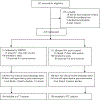Moment-by-Moment in Women's Recovery (MMWR): Mindfulness-based intervention effects on residential substance use disorder treatment retention in a randomized controlled trial
- PMID: 31419610
- PMCID: PMC6721972
- DOI: 10.1016/j.brat.2019.103437
Moment-by-Moment in Women's Recovery (MMWR): Mindfulness-based intervention effects on residential substance use disorder treatment retention in a randomized controlled trial
Abstract
In this study we test the efficacy of Moment-by-Moment in Women's Recovery (MMWR), a mindfulness-based intervention adapted to support women with substance use disorder (SUD) while in residential treatment. We use a parallel-group randomized controlled trial with a time-matched psychoeducation control to test MMWR effects on residential treatment retention. We used clinical staff-determined residential site discharge status and discharge date from the SUD treatment site record to determine retention. We tested for study group differences in retention defined as time to treatment non-completion without improvement (i.e., patient left treatment before completion of the treatment plan and made little or no progress toward achieving treatment goals based on clinical team determination), as well as differences in self-report of study intervention mechanisms of action (i.e., mindfulness, perceived stress, distress tolerance, emotion regulation, distress, affect, and drug and alcohol craving). The analytic timeframe for the survival analysis was from study intervention start date to 150 days later. The sample (N = 200) was female, majority amphetamine/methamphetamine users (76%), Hispanic (58%), with a history of incarceration (62%). By the 150-day analytic endpoint, the sample had 74 (37%) treatment Completers, 42 (21%) still In-residence, 26 (13%) Non-completers with satisfactory progress, and 58 (29%) Non-completers without satisfactory progress. Survival analysis of the intent-to-treat sample showed the risk of non-completion without improvement was lower in MMWR as compared to the control group (adjusted hazard ratio = 0.42, 95% CI: 0.16-1.08, p = .07). Both groups improved on select self-reported mechanism measure scores at immediate post-intervention, but only in the MMWR group did class attendance (dosage) have a large-size correlation with improved mindfulness (r = .61, p < .01), distress tolerance (r = 0.55, p < .01) and positive affect (r = 0.52, p < .01) scores. The hazard ratio for retention was of medium-to-large effect size, suggesting the clinical relevance of adding MMWR to an all-women's, ethnoracially diverse, SUD residential treatment center. An extended curriculum may be helpful considering the protective benefits of class attendance on psychological health indicators.
Keywords: Dropout; Mindfulness; Residential; Retention; Substance use disorder; Women.
Published by Elsevier Ltd.
Conflict of interest statement
Conflict of interest statement: All authors declare that there are no conflicts of interest.
Figures


References
-
- Brorson HH, Ajo Arnevik E, Rand-Hendriksen K, Duckert F. Drop-out from addiction treatment: a systematic review of risk factors. Clin Psychol Rev. 2013;33(8):1010–1024. - PubMed
-
- McLellan AT, Lewis DC, O’Brien CP, Kleber HD. Drug dependence, a chronic medical illness: implications for treatment, insurance, and outcomes evaluation. JAMA : the journal of the American Medical Association. 2000;284(13):1689–1695. - PubMed
-
- Hser YI, Evans E, Huang D, Anglin DM. Relationship between drug treatment services, retention, and outcomes. Psychiatr Serv. 2004;55(7):767–774. - PubMed
-
- Simpson DD, Joe GW, Brown BS. Treatment retention and follow-up outcomes in the Drug Abuse Treatment Outcome Study (DATOS). Psychology of Addictive behaviors. 1997;11(4):294.
-
- Condelli WS, Koch MA, Fletcher B. Treatment refusal/attrition among adults randomly assigned to programs at a drug treatment campus: The New Jersey Substance Abuse Treatment Campus, Seacaucus, NJ. J Subst Abuse Treat. 2000;18(4):395–407. - PubMed

